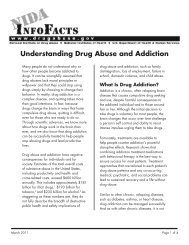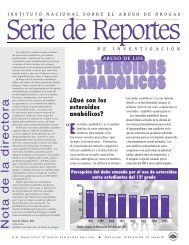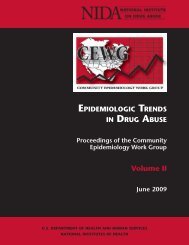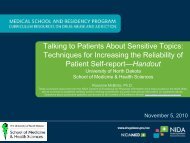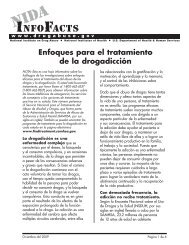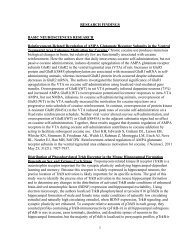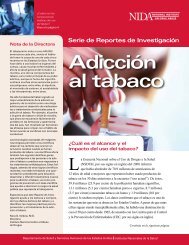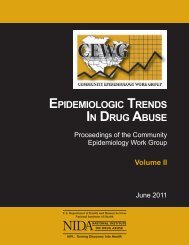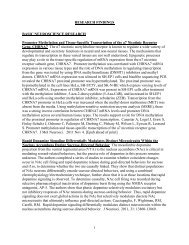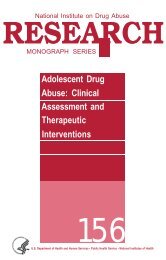CEWG January 09 Full Report - National Institute on Drug Abuse
CEWG January 09 Full Report - National Institute on Drug Abuse
CEWG January 09 Full Report - National Institute on Drug Abuse
You also want an ePaper? Increase the reach of your titles
YUMPU automatically turns print PDFs into web optimized ePapers that Google loves.
EpidEmiologic TrEnds in drug AbusE: HigHligHTs And ExEcuTivE summAry<br />
with Whites and African Americans, the number<br />
of cocaine-related primary treatment admissi<strong>on</strong>s<br />
for Hispanics more than doubled in the first half<br />
of 2008 (1.7 percent in 2007 to 3.5 percent in the<br />
first half of 2008). Nearly 8 out of 10 of all cocaine<br />
users who entered treatment preferred to smoke<br />
the drug, a proporti<strong>on</strong> that has remained stable<br />
over the last 6 years. Two drug surveillance organizati<strong>on</strong>s—the<br />
<strong>Drug</strong> Enforcement Administrati<strong>on</strong><br />
(DEA) and the Atlanta High Intensity <strong>Drug</strong><br />
Traffcking Area (HIDTA)—reported a decrease<br />
in cocaine supply for Atlanta in the first half of<br />
2008. This reduced supply did impact the local<br />
cocaine market, whereas the wholesale, mid-level,<br />
and retail price of powder cocaine increased and<br />
purity levels decreased. Street-level ethnographic<br />
reports c<strong>on</strong>firmed brief shortages of powder<br />
cocaine at the retail level in the first half of 2008.<br />
However, no changes in the price or purity levels<br />
of crack/cocaine were reported in Atlanta. Mexican<br />
drug traffcking organizati<strong>on</strong>s (DTOs) have<br />
strengthened c<strong>on</strong>trol over the cocaine transportati<strong>on</strong><br />
and wholesale distributi<strong>on</strong> in Atlanta. Atlanta<br />
remains the leading cocaine staging and distributi<strong>on</strong><br />
hub for the East Coast (including Miami<br />
and New York City). Am<strong>on</strong>g law enforcement<br />
agencies in metropolitan Atlanta counties, 19 of<br />
28 reported that crack/cocaine was most resp<strong>on</strong>sible<br />
for violent crimes in their jurisdicti<strong>on</strong>s, an<br />
increase from 2007. Marijuana remains the most<br />
comm<strong>on</strong>ly used substance in Atlanta. Ethnographic<br />
reports suggest that supply for marijuana<br />
is easily available and price levels for Mexicangrown<br />
marijuana have remained stable. However,<br />
the supply of “BC Bud” from British Columbia<br />
and hydrop<strong>on</strong>ic marijuana has increased,<br />
thereby driving retail prices down. Cuban-based<br />
DTOs have increased their efforts in distributing<br />
lower price marijuana in Atlanta. Local indoor<br />
cultivati<strong>on</strong> of more potent hydrop<strong>on</strong>ic marijuana<br />
increased in the first half of 2008, and law<br />
enforcement offcials cited an increased influence<br />
of Asian DTOs in its producti<strong>on</strong> and distributi<strong>on</strong>.<br />
Street-level ethnographic reports suggested<br />
that retail dealers of marijuana also sell crack<br />
and powder cocaine, but not methamphetamine.<br />
Several indicators, including statewide medical<br />
examiners postmortem occurrence, pris<strong>on</strong> and<br />
public treatment admissi<strong>on</strong>s, and NFLIS drug<br />
seizure data, were down with regard to the use<br />
of methamphetamine. In the first half of 2008,<br />
methamphetamine-related treatment admissi<strong>on</strong>s<br />
decreased to 6.2 percent from 7.7 percent in 2007,<br />
dropping nearly 44 percent from the drug’s peak<br />
use in 2005. During the first half of 2008, women<br />
entering substance abuse treatment for methamphetamine<br />
outnumbered men (62 versus 38<br />
percent), a c<strong>on</strong>sistent trend that c<strong>on</strong>trasts with<br />
findings from other <str<strong>on</strong>g>CEWG</str<strong>on</strong>g> reporting cities. The<br />
proporti<strong>on</strong> of methamphetamine-related primary<br />
treatment admissi<strong>on</strong>s smoking the drug stabilized<br />
in the first half of 2008 at close to 60 percent—<br />
c<strong>on</strong>sistent with the previous year when a leveling<br />
off was indicated after six c<strong>on</strong>secutive increases<br />
in smoking-related primary methamphetaminerelated<br />
admissi<strong>on</strong>s. Law enforcement offcials<br />
noted a slight decline in the importati<strong>on</strong> of Mexican<br />
“ice” in metropolitan Atlanta, while suggesting<br />
that local producti<strong>on</strong> of methamphetamine<br />
increased, especially in the more rural counties of<br />
the metropolitan Atlanta area. Although Whites<br />
were the most frequent users of methamphetamine,<br />
indicators suggested a growing level of<br />
methamphetamine use occurred am<strong>on</strong>g African<br />
Americans and Hispanics. Street-level ethnographic<br />
reports have found greater cross-over<br />
use of methamphetamine by n<strong>on</strong>-White crack/<br />
cocaine users. Heroin indicators c<strong>on</strong>tinued to<br />
show stable levels of use with the majority of users<br />
c<strong>on</strong>centrated in Atlanta’s Bluff district. However,<br />
due to several high-profile heroin-related deaths<br />
in 2008, law enforcement increased its presence<br />
in this community, resulting in a greater number<br />
of arrests and drug seizures during the first half<br />
of 2008, as evidenced by a 168-percent increase<br />
in NFLIS’s drug identificati<strong>on</strong> and seizure data.<br />
Street-level ethnographic findings suggest that<br />
drug distributi<strong>on</strong> may be moving outside the Bluff<br />
district and into the Downtown and Midtown<br />
secti<strong>on</strong>s of metropolitan Atlanta. Rates of injecting<br />
South American (SA) heroin have increased<br />
due to decreased purity levels and increases in<br />
34<br />
Proceedings of the Community Epidemiology Work Group, <str<strong>on</strong>g>January</str<strong>on</strong>g> 20<str<strong>on</strong>g>09</str<strong>on</strong>g>



